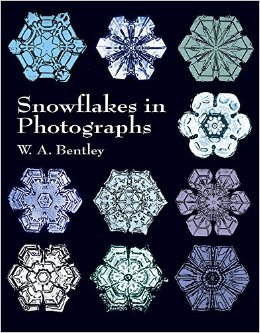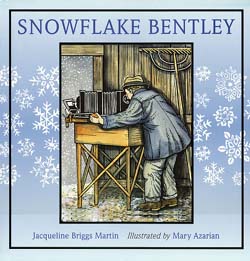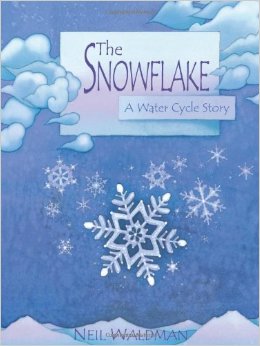Getting kids interested in science can be challenging. The Library of Congress has many online resources available to K-12 educators and their students including lesson plans, reading lists, and more that each relate to a specific topic in science. You can find these resources by visiting https://www.loc.gov/education/. This month we are featuring the list entitled, “Snow: Flakes and Crystals.” The list is found at https://www.loc.gov/rr/scitech/SciRefGuides/snowflake.html.
No two snowflakes are alike. We say this all the time, but is it true? Of the literally billions and billions of snowflakes on the Earth at any given time, can no two anywhere at all ever be alike? It’s difficult to imagine the number of snow crystals present on Earth right now. Wilson A. Bentley, one of the first known photographers of snowflakes, was a man fascinated by snow, weather, and the water cycle. After looking at many of his photographs, you may come to the same conclusion that no two snowflakes are alike.
 A book that will help you do just that is Snowflakes in Photographs, by W. A. Bentley. A more recent compilation of Bentley’s famous snowflake photographs, the book is page after page of black and white images of snowflake crystals and some images of dew drops, frost, and other dihydrogen monoxide representations. Looking at these images may lead you to wonder about the man so devoted to snow that he was given the nickname, Snowflake Bentley. 72 pages including introduction; published by Dover Publications, ISBN-13 978-0-486-41253-5
A book that will help you do just that is Snowflakes in Photographs, by W. A. Bentley. A more recent compilation of Bentley’s famous snowflake photographs, the book is page after page of black and white images of snowflake crystals and some images of dew drops, frost, and other dihydrogen monoxide representations. Looking at these images may lead you to wonder about the man so devoted to snow that he was given the nickname, Snowflake Bentley. 72 pages including introduction; published by Dover Publications, ISBN-13 978-0-486-41253-5
A good biography of Bentley is The Snowflake Man, by Duncan C. Blanchard. It’s very detailed, going into depth about his family’s history and origins in New England, and includes a small set of photographs of Bentley’s childhood home, some of his family members, and a few snow crystal photographs. This book is definitely an adult read, and is particularly interesting if you are like early American history or genealogy. 237 pages, published by The McDonald and Woodward Publishing Company, ISBN 0-939923-71-8
For younger readers, a great choice would be Caldecott Medal winner, Snowflake Bentley, by Jacqueline Briggs Martin with illustrations by 
Mary Azarian. The book gives children highlights of Bentley’s childhood and early interest in all things frozen and illustrates well the sacrifice made by Bentley’s parents to buy an expensive camera and microscope to fuel Bentley’s obsession. Interjected among the biographical prose are additional facts that older or more curious readers will want to know, such as an explanation of the magnification capabilities of the camera and microscope. 32 pages, published by Houghton Mifflin Company, ISBN 0-395-86162-4
 And finally, there’s a beautifully illustrated book about the object of Bentley’s passion, the snowflake. The Snowflake: A Water Cycle Story, by Neil Waldman, follows a fictitious droplet of water from snow crystal in the sky, through its multiple forms and reservoirs on Earth, and back to crystal in the sky. Laid out as a seasonal or calendar progression, each page represents one month in the droplet’s cycle on Earth. The illustrations look and give the feeling of the Northern Hemisphere season associated with the months listed. For example, in March, the droplet is part of a mountain stream flowing down through a crack in the Earth beneath a frozen pond. The colors are warm above, representing the warming days, and cool and blue beneath, illustrating the still-frozen ground. 32 pages, published by Millbrook Press, ISBN-13 978-0761323471.
And finally, there’s a beautifully illustrated book about the object of Bentley’s passion, the snowflake. The Snowflake: A Water Cycle Story, by Neil Waldman, follows a fictitious droplet of water from snow crystal in the sky, through its multiple forms and reservoirs on Earth, and back to crystal in the sky. Laid out as a seasonal or calendar progression, each page represents one month in the droplet’s cycle on Earth. The illustrations look and give the feeling of the Northern Hemisphere season associated with the months listed. For example, in March, the droplet is part of a mountain stream flowing down through a crack in the Earth beneath a frozen pond. The colors are warm above, representing the warming days, and cool and blue beneath, illustrating the still-frozen ground. 32 pages, published by Millbrook Press, ISBN-13 978-0761323471.
Whether you want more snow, or less, whether you love it or hate it, snow is a part of our life as residents of North America. It has been present in every US state and Canadian province at one time or another and is here to stay for the time being (sorry, warm weather lovers). The list of resources published by the Library of Congress can help you and your students develop a deeper understanding and appreciation for the intricacies of snowflakes. Now, who has some hot chocolate?
Want to learn how to make a six-sided snowflake? Check out a step by step instruction sheet here!
